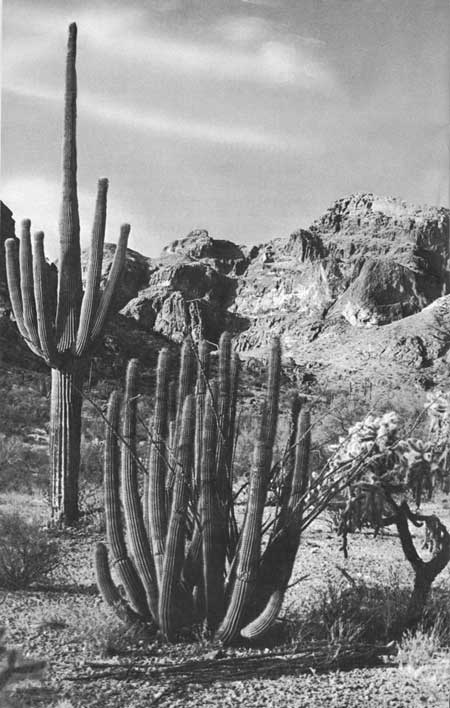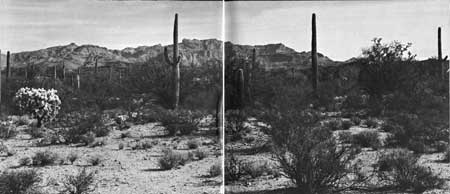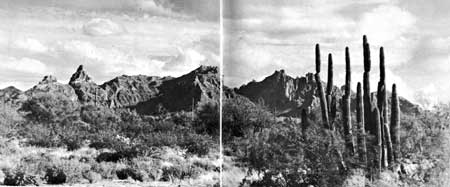|
ORGAN PIPE CACTUS National Monument |
 |
NEAR ARIZONA'S RENDEZVOUS WITH CALIFORNIA AND MEXICO, there is a world of space and color. Its horizons appear held apart by sky, its mountains look flatly two-dimensional, and its spectacular vegetation seems borrowed from another planet.
Reaching northward from the wilderness of northwestern Sonora, a sub-tropical finger of the Mexican gulf coast desert extends from the Gulf of California into a broad, mountain-fringed valley of southwestern Arizona. Accompanying a relatively frost-free climate, this vegetative probe meets the eastern edge of the California microphyll desert and the western rim of the Arizona succulent desert.

Here, within the 516 square miles of Organ Pipe Cactus National Monument, plants and animals of these three phases of the great Sonoran Desert merge to form rich and varied biological communities. This scenic wilderness of rugged mountains, cactus-studded slopes, and desert flats is an American heritage preserved for the enjoyment of the people. Bathed in bright sunlight and clean, clear air, this amazing world awaits your discovery.
Desert Landscapes
IF YOU PASS THROUGH the north entrance of Organ Pipe Cactus National Monument on an early spring morning following a relatively wet winter, you will be greeted by an amazing display of luxuriant vegetation and colorful wildflowers. Road shoulders gleam with desertgold and desert baileya. A blanket of purple escobita, mingling with blue lupines and yellow Mexican goldpoppies carpets the desert floor. Hillsides glow with clumps of daisylike brittlebush, and desert washes are fringed with paloverde trees, their new leaves hidden beneath a mass of yellow flowers.
"Can this paradise be a desert?" you exclaim.
The biologist regards as deserts those regions in which "deficient rainfall and all its consequences have made a strong impression on the structure, functions, and behavior of living things." The climate of the desert often presents the upper limits of temperature and the lower limits of moisture in which plants can grow and animals survive.

Many centuries ago primitive Indians learned to live in precise adjustment to the severe, unchanging requirements of this hot, dry environment; they, too, are a part of its native life.
It has been only since the 1930's that mankind brought to the desert the conveniences and comforts of modern civilization. Surrounded and fortified with these, you will find that the desert is a strange, beautiful, and thoroughly delightful place in which to visit and to live. You will find that it presents for your pleasure and exploration a great many appealing, significant, and almost unbelievable facets of nature.
Mountains rising from the desert provide environments for many different plant and animal communities and ecological niches in addition to those found in the surrounding lowlands.


|

|
| NPS History | History & Culture | National Park Service | Contact |
|
Last Modified: Sat, Nov 4 2006 10:00:00 pm PST |


